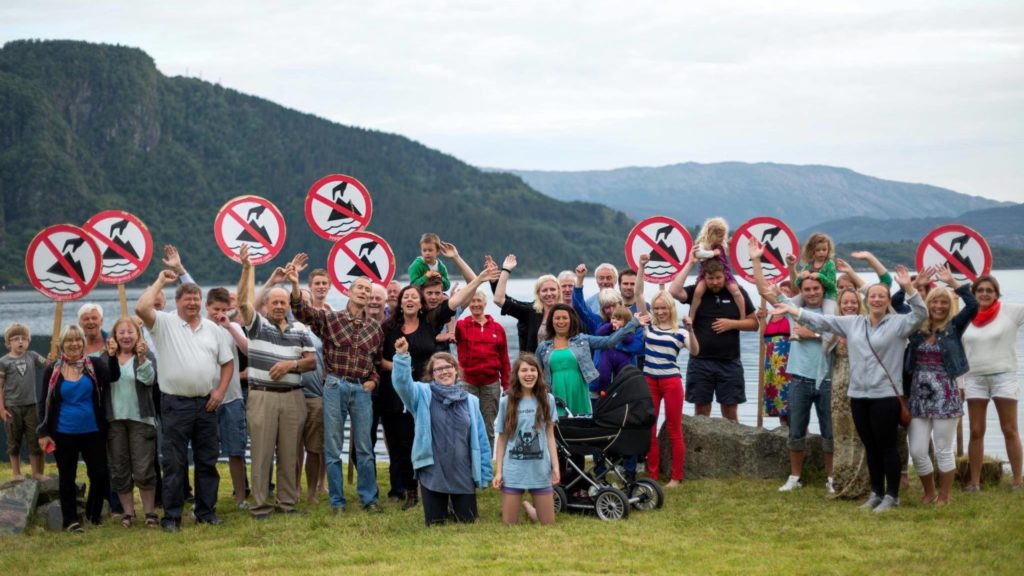
Nordic Mining’s threat to a fertile fjord
Nordic Mining has begun test drilling for a new open-pit rutile and garnet mine near the community of Vevring located in a region on Norway’s west coast famous for its fjords. If constructed, the mine would remove the top of the Engebø Mountain and dump 250 million tonnes of mine waste directly into the fish-rich Førdefjord. Nordic does not yet have the final permits necessary to operate, and it’s February 2020 feasibility study ignores major obstacles still standing in the way of the project.
Fjords at risk
Norwegians take their fjords seriously, and for good reason: fjords are critical to Norway’s identity and economy. A diverse coalition, including national fishermen organizations, tourism operators, coastal communities, and environmental groups are united over concern that Nordic’s mine will have an irreversible, catastrophic impact on the iconic fjord and communities that rely on it. For two weeks, impacted community members and activists from across Norway locked themselves to Nordic Mining’s machinery and stopped construction of the Engebø mine.
The Norwegian Parliament has declared the Førdefjord a National Salmon Fjord, connecting the open sea with a permanently-protected river and important spawning grounds for salmon, cod, halibut, and herring. The fjord is home to pristine corals and is regularly visited by orca whales and sea eagles and supports thriving seafood, sport, and commercial fishing industries. Tourism is critical to the regional economy; the local tourism board has called Nordic Mining’s project a “catastrophe for modern business.”
Norwegians’ concerns over the mine are well-founded. An Institute for Marine Research study found few signs of life on the bottom of the Jøssingfjord 35 years after dumping ceased at Titania’s Tellnes mine in southern Norway. Scientists are concerned it may never fully recover.
Norway stands alone in Europe
Norway is the only country in Europe currently allowing mining companies to dump solid mine waste directly into open water bodies. The country approved the project over the objections of its environmental ministry. A number of Norwegian, Danish, and Swedish banks and pension funds are the project’s major shareholders, in addition to thousands of small investors and global banks like Citigroup, which hold shares in custody accounts on behalf of clients. Concern about the environmental impact of ocean dumping pushed Nordea Bank, Nordic Mining’s third largest shareholder, to divest from the company in September 2022.
In January 2018, the Norwegian government placed a four-year ban on new permits to dump mine waste to allow time for a thorough economic and environmental analysis of the practice. The decision does not immediately impact Nordic Mining’s project, which has already been permitted to dump. Unfortunately, the ban was lifted in 2021 when a new government was elected.
“By calling for a ban on mine waste dumping into the sea, the government has revealed that they know the practice is environmentally unacceptable in 2018. The species-rich Førdefjord is an international treasure and the foundation of our livelihoods in coastal Norway. We must protect it and stop polluting the world’s already struggling oceans. ”
Anne-Line Thingnes Førsund, born and raised in Vevring, near Nordic Mining’s proposed mine
What are Tailings?
Tailings are the sludge left once the mineral is extracted from the ore. They contain crushed rock, processing chemicals and naturally occurring elements that become toxic when exposed to air or water. This toxic cocktail settles on and smothers the seafloor, killing everything that lives there. Tailings can also spread, contaminating other areas and destroying coral reefs and other habitat. Mining companies can avoid this dangerous waste disposal option in favor of safer, less destructive methods on land. However, it is important that land-based waste storage facilities have strong safety standards and appropriate oversight.
